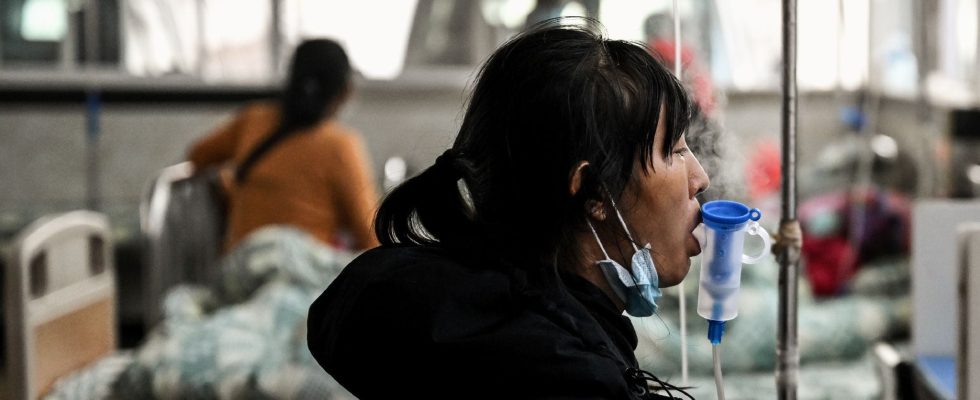Like an air of Back to the future in China. For a few hours, the country seemed to have returned four years earlier, at the end of 2019, when cases of pneumonia of unknown origin suddenly appeared in Wuhan hospitals. A few weeks later, the world will learn of the emergence of a new virus called Sars-CoV-2, before the World Health Organization (WHO) considers this disease, Covid-19, as a pandemic. The world is in lockdown and the dead are now numbered in the millions. Scalded and criticized for its lack of responsiveness in 2019, the UN health organization therefore decided to react quickly and strongly when it learned of an increase in cases of respiratory diseases in China in recent weeks. Enough to revive bad memories. But what do we really know?
First of all, the first alert did not date from yesterday, but from October 12. On that day, Chinese pediatricians mentioned in the Global Times (a newspaper affiliated with the Chinese Communist Party) an increase in cases of infections Mycoplasma pneumoniae, a bacteria present all over the world and responsible for cases of pneumonia in children and young adults. The information goes relatively unnoticed, and the weeks pass. On November 13, in front of the press, the Chinese authorities returned to this increase in respiratory illnesses, which they attributed to the abandonment this year of anti-Covid health restrictions and the circulation of known pathogens. New item, Tuesday November 21. Chinese official media and the global disease surveillance system ProMED are reporting cases of pneumonia in children in the north of the country. This is when the world really becomes aware of this information. The next day, Wednesday November 22, the WHO asked the Chinese authorities for more detailed information “on an increase in respiratory illnesses and outbreaks of pneumonia reported in children.”
So far relatively silent, China responds within 24 hours, in accordance with the rule in force. Thursday evening, November 23, the WHO indicated that Beijing had not detected any new pathogens. “Chinese authorities have indicated that no new or unusual pathogens have been detected, nor unusual clinical signs, including in Beijing and Liaoning, but only the general increase in the number of cases of respiratory illnesses due to pathogens known,” the organization said in a statement. She recommends that the population respect “measures aimed at reducing the risk of respiratory disease”. Already recommended during the Covid-19 pandemic and during epidemics in general, these include vaccination, distancing from patients, isolation in the event of symptoms, tests and care if necessary as well as the wearing of mask.
Pediatric services under pressure
The country’s epidemiologists assure: as the first winter approaches since the lifting of zero Covid restrictions, natural levels of immunity against several pathogens (flu, bronchiolitis virus, Covid-19 and Mycoplasma pneumoniae) could be lower than normal, leading to an increase in infections. Information confirmed ten days ago by Wang Quanyi, deputy director of the epidemic prevention center of the city of Beijing in Global Times : “A resurgence of Mycoplasma pneumoniae has been detected for three months, but the circulation of this bacteria is in a declining phase”. An argument confirmed by the cold wave which is currently hitting northern China, and in particular Beijing, with negative temperatures. The city “is entering a season with a high incidence of infectious respiratory diseases”, Wang Quanyi reminded the press on Wednesday. Although no figures have been officially disclosed on the number of patients concerned, the official media Global Times reports an increase “of 30 at 50%” of the attendance of the pediatric department of the Aviation Hospital, in Beijing, compared to the same period in previous years. Other cities, such as Tianjin or Shenyang, respectively 150 and 700 kilometers away from Beijing, would have pediatric services “under high pressure”.
Contacted by L’Express, Hervé Fleury, professor emeritus at the CNRS and the University of Bordeaux and author of Emerging and re-emerging viruses (Elsevier Masson), believes that there is “nothing worrying” at this stage, and recalls that “this is the first winter after the end of Sars-CoV-2 confinement in China, this could promote the circulation of winter viruses in the general population. Remember that several Western countries, including France, experienced significant waves of respiratory viral infections during the first winter after the lifting of Covid restrictions. For young children in particular, lockdowns have delayed the age at which they were first exposed to common germs or viruses. The French virologist therefore wants to be reassuring: “It would not be a new emerging virus like Sars-CoV-2 at the end of 2019”. And to qualify: “These answers seem relevant and reassuring but it will be necessary to monitor the laboratory data on the identification of the viruses and bacteria involved”. Because the Beijing authorities’ taste for secrecy necessarily calls for caution. The WHO had in fact criticized the Chinese authorities for their lack of transparency during the investigation into the origins of Covid-19. This investigation has still not reached a definitive conclusion.
Finally, the bacteria Mycoplasma pneumoniae is well known, it occurs periodically every 3 to 7 years, depending on the period and the region. After disappearing from the radar with the Covid pandemic due to health restrictions, it has made a comeback in many countries since the start of the year. And researchers note an “acceleration”. In France, several cases have been reported recently, particularly in Île-de-France and in the Auvergne-Rhône-Alpes region, in children aged 5 to 10 years.
.
